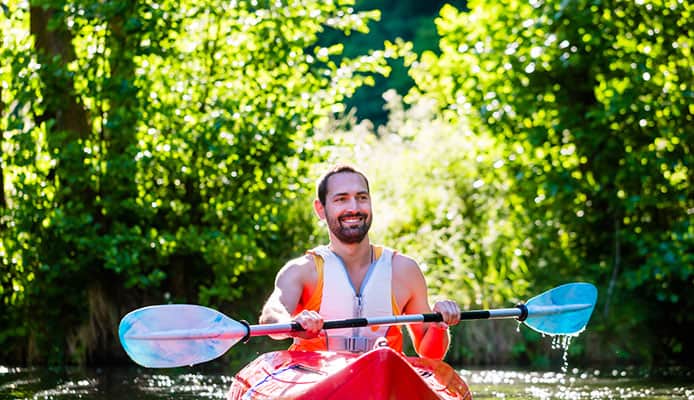
There are plenty of situations that can cause water to get into a kayak. Think of kayaking in white waters for example where you will require a whitewater kayak. When you are out kayaking by yourself, you can’t obviously sit in a wet boat. You will need to know how to get water out of a kayak.
It can seem daunting to try and empty the cockpit of a kayak when you are alone in the water. First of all, the kayak is going to feel heavy when paddling. To lift the kayak from the water will also require a lot of effort.
Before you can make your first move, you will need to first analyze the situation. Are you a far distance from land? Is the cockpit full of water?
If for example you are not very far from shore and the sit on top kayak cockpit is filled with water, you may want to save your energy and just grasp the kayak bow and swim for the shore while dragging the kayak. It will be much easier to handle the kayak while on dry land.
Once you have pulled the kayak to the shore, simply lift it by the bow and then tilt the kayak to empty the cockpit. Note that you may have to do this several times to ensure all the water is drained completely.
However, if you are quite a distance away from the shore, then swimming while dragging the kayak may not be the best option. You will have to empty your kayak while in the water.
Emptying when in the water
The first step on how to get water out of a kayak is to swim to the bow. Grab the bow with your hands all while ensuring you do not lose your kayak paddle. A paddle tether will ensure that the paddle doesn’t drift away. If you don’t have a tether, then grab the paddle and have it close to you.
Second, kick your legs as much as you can to lift your body out of the water while using your hands to lift the kayak such that the cockpit clears the water. This is one way on how to drain a kayak. If you have the energy, you can rock the cockpit back and forth to ensure that all the water drains out.
Once the water has drained, flip the kayak over and climb back onto the cockpit.
If you are not a strong swimmer there is another way to lifting the cockpit out of the water. Simply swim to the stern and climb on it. Then flip the kayak and climb on. If you have a heavier fishing kayak with more accessories then this is an excellent way to right the kayak.
Sometimes it’s just impossible to clear out all of the water. Having a bilge pump can help greatly especially if you are kayaking in rough waters. Bilge pumps for kayaks are also quite affordable and simple to obtain.
Using an assisting kayaker
I say you were kayaking in the ocean with your ocean kayak and there is not too much water in the kayak cockpit and you are wondering how to get water out of the kayak, using an assisting kayaker is a highly effective way on how to drain the kayak.
The first thing that you will need to ensure is that you have the kayaker assisting the paddle at your location. Ensure that the bow of their kayak is positioned perpendicular to the bow of your kayak.
You might also like: Plastic Kayak Repair Guide
Next push your kayak such that it slides on the kayak assisting such that the cockpit is raised above the water.
The last step will involve you flipping the kayak to its right position. Do this while moving it away from the kayak assisting. One of the main advantages of this method is that there is less effort required to flip the kayak.
However, there is a downside as it may cause the kayak that is assisting you to flip over resulting in yet another problem. If you are helping your buddy, one of the most important things that you will need to ensure is that your own kayak remains stable so that it doesn’t capsize.
Globo Surf Overview
When kayaking out in rough waters, just one strong wave can capsize your kayak sending you into the watery blue. Knowing how to drain a kayak and get back on it is, therefore, a skill that every kayaker should be conversant with.
Being in the water for too long can cause hypothermia so it’s paramount that you can drain your kayak and get on as fast as possible especially when the water is cold.
More Skils Guides:
- How To Do Kayaking Upstream
- Kayak And Canoe Oil Canning Guide
- How To Lock A Kayak – Keep Your Kayak Safe At Any Time
- How To Tie Down And Transport A Kayak In A Truck Bed
- How To Wax Your Kayak?
- Is Snow Kayaking Possible?
- Kayak Techniques: The Stern Rudder
- Kayak Rescue Guide: The T Rescue
- How To Properly Strap Two Kayaks Into A Car Roof Rack
- How To Roll A Kayak

